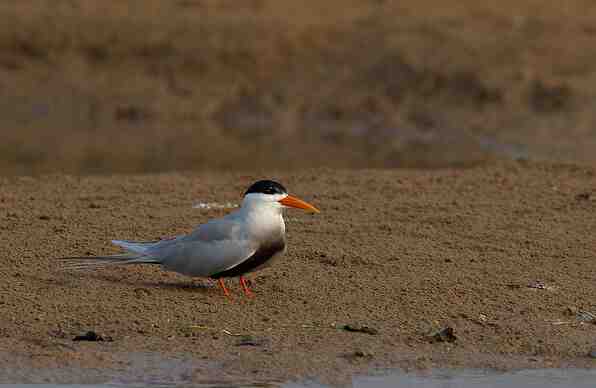Sterna acuticauda
IUCN
LCBasic Information
Scientific classification
- name:Sterna acuticauda
- Scientific Name:Sterna acuticauda,Black-bellied Tern
- Outline:Waterfowl
- Family:Lariformes Laridae Terns
Vital signs
- length:29-32cm
- Weight:62-68g
- lifetime:20-30years
Feature
Lower thorax, abdomen, and tail undercover black
Distribution and Habitat
It is distributed in Bangladesh, Cambodia, India, Laos, Myanmar, Nepal, Pakistan, Thailand and Vietnam.
Traveler: China
They inhabit inland rivers, lakes, reservoirs and adjacent paddy fields.
Appearance
The crown of the summer feather from the forehead to the pillow, including the crown feather glow black. The base of the forehead is sometimes marked with white. The back, shoulders and wings are covered with gray feathers; Waist, tail covering and tail light gray. The tail is deeply forked. The longest outer tail feathers are almost white on the outside, and the flight feathers are lighter and grayish. Primary feathers with dark brown apex. The eyes, cheeks, chin, and throat are white, and the upper chest gradually becomes gray, and the lower chest, abdomen, and tail are black. Underwing coverts and axils white.
The head of the winter feather is white, the pillow has black longitudinal stripes, and there is a black spot behind the eyes. The underbody is white, and the front neck and chest are gray. Sometimes with black spots, others like summer feathers.
The juvenile upper body is yellowish-gray, with pale yellowish-white feather margin and black subtip spots, and the inner seco
Details
The Black-bellied Tern is a small waterbird with no subspecies.

Black-bellied terns often fly over the waters. It's very rare to stop. The black-bellies mainly feed on small fish. They also eat shrimp, tadpoles, crustaceans, and insects. Often dive underwater to hunt fish. When food is found in the water, it dives vertically and dives to hunt.
The breeding season of black-bellied terns is from March to May. Nests are built on bare sand near open water, and occasionally in sparse grass. They often breed together in groups. Each litter lays 2~4 eggs, mostly 3 animals. The eggs are obtuse oval in shape and are shar yellow in color, with light brown or reddish-brown spots. There are also individual white or light green. The size of the eggs is 30-36 × 23-26 mm. The male and female incubate the eggs in turn. Incubation period is 15 to 16 days.
In southern Asia, where the black-bellied tern is almost extinct in a large part of its range due to numerous threats affecting riverine species, the overall decline has been very rapid. Therefore, it has been listed as endangered.
It was included in the List of Land Wild Animals under State Protection that are beneficial or have important economic and scientific research value (Item 204) issued by the State Forestry Administration of China on August 1, 2000.
Listed on the International Union for Conservation of Nature Red List of Threatened Species (IUCN) in 2016 ver 3.1 - Endangered (EN).
Listed in China's "National Key Protected Wildlife List" (February 5, 2021) Level 2.
Protect wild animals and eliminate wild meat.
Maintaining ecological balance is everyone's responsibility!








